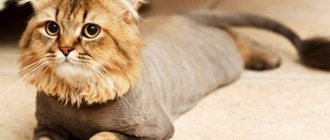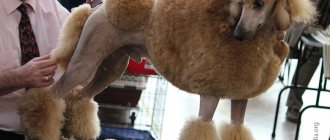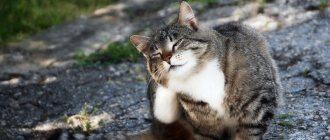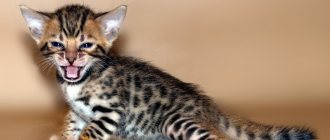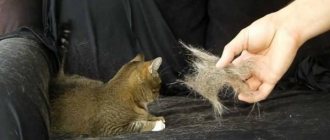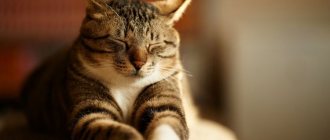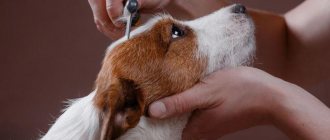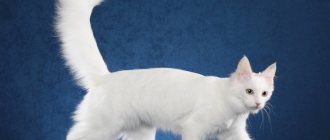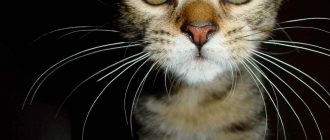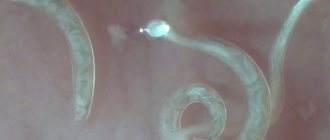Save the article:
Not everyone knows what cat grooming , although they are familiar with some pet care procedures. Grooming is an English term denoting cosmetic and hygienic procedures for caring for one’s appearance, including washing, cutting, treating nails and other actions.
In many English cities, grooming is a concept that applies to both people and animals. Not so long ago there was a profession of a groom - a groom, whose duties included caring for horses, and today there is a profession of a groomer. These are specialists who bring shine to pets.
Unfortunately, some owners consider caring for the appearance of their pets a privilege of exhibitions, but when was caring about hygiene and beauty superfluous?
Story
Grooming appeared in ancient times; initially, almost the only animals that were so carefully looked after were horses.
In medieval England, grooms were precisely those grooms who combed the hair of horses. With the advent of decorative long-haired dog breeds, groomers have more work to do. Poodles played a special role in the development of modern grooming, since this breed of dog requires careful and constant care for its coat. At the same time, the poodle needs to not only be bathed regularly, but also trimmed in a certain way. The breed experienced a surge in popularity in the mid-20th century. As a result, around this time, many grooming salons began to appear in the United States. Nowadays, grooming is considered the norm not only for dogs, but for almost all pets.
Why choose us
- Quality and safety: only professional tools and cosmetics are used.
- In our salon only the most modern equipment is an important condition for high-quality grooming.
- We provide highly professional haircuts for dogs, taking into account the breed and complexity.
- The clinic employs high-class masters, for whom grooming is not just a profession, but a vocation.
- We use only sterile instruments.
- We guarantee an individual approach to each four-legged client.
- We are for humane treatment of animals.
Types: hygienic and exhibition
There are two main types of grooming: hygienic and exhibition. The first type of care is aimed at maintaining optimal hygiene for the pet. This grooming consists of a set of basic procedures:
☑️ swimming;
☑️ antiparasitic treatment;
☑️ combing and removing tangles;
☑️ trimming nails and cutting hair between fingers (for dogs);
and other hygiene procedures.
If the animal regularly participates in exhibitions, the second stage of hygienic grooming is exhibition grooming. It is aimed at giving your pet an ideal appearance. Exhibition grooming includes cosmetic procedures such as trimming, coat dyeing, special creative haircuts, and treatment of coat with shine-inducing products.
Exhibition grooming is usually carried out only a few times a year. While a pet constantly needs basic care. It is worth remembering that decorative grooming is impossible without first undergoing hygiene procedures.
Why do you need hygienic cat grooming?
Keeping your cat's fur clean is key to its health and well-being. If you do not pay proper attention to the care of the coat, it can become tangled. In addition, after grooming, the pet looks well-groomed, its fur shines and smells pleasant, which cannot but please the owner.
Claw treatment
To trim cats' claws, you need to purchase special nail clippers. It is not recommended to use ordinary nail scissors, as they can damage the nail plate and cause it to break.
Claws should be trimmed only from above, to a length of no more than 1.5 mm.
If your pet is often outdoors, its paws should be regularly inspected for wounds, abrasions or splinters.
Also watch the video of salon cat grooming:
Is it worth doing this?
First you need to make the right decision: whether to cut your cat's hair. Not all cats require this type of care. Some longhairs live well their entire lives without ever visiting a stylist.
But if your cat's hair is matted, trimming is the way to go. The best option in this case is professional haircuts done in pet salons. A grooming specialist will carry out the procedure quickly and efficiently, and will select the best hairstyle for your pet.
But there are times when you really need to rid your pet of long hair, and a good groomer is not available at that moment. Then you can gain strength, caution, prepare and cut your cat’s hair yourself.
Why do you need to cut your hair?
It is worth trimming your cat's body hair if someone in your household is allergic to cat hair. The cat may also develop mats or begin to shed. In these cases, you can also solve the mentioned problems. You should avoid unnecessary shaving in the following cases:
- Your cat's fur is good at regulating body temperature in both summer and winter. If you remove too much hair from an animal, you may disrupt this process.
- A long-haired cat just needs a bath to cool it down in the heat.
- Not all cats need to be clipped. Severely aggressive, elderly or sick cats may be subject to stress or cuts during shaving.
Consider professional performance
Sometimes it is best to find out the location of grooming salons in your city and the cost of their services. This may be the best option for your pet. Grooming specialists know well how to care for a cat's coat. Therefore, it is better to entrust the haircut to a professional. Although the cost of getting a haircut at a salon can be quite high, it is worth it. Groomers are less likely to accidentally cut your cat and know how to keep pets calm during the grooming process.
- Prices vary depending on what service you need. If you want a basic treatment (rather than a full cut), the cost will be lower.
Consult your veterinarian
Before grooming your cat, consult your veterinarian. If mats have formed in your pet's fur, your veterinarian may prefer to remove them yourself. In addition, your pet doctor may advise you not to cut your cat's hair, to do it only during certain seasons, to give recommendations on grooming for the groomers themselves and on the choice of tools.
What do you need to know before grooming your cat?
- Before the exhibition, the cat is cut no later than six months in advance. It is impossible to cut your hair bald with such plans.
- Restless cats are given muscle relaxants.
- After trimming, the structure and color of the coat may change, but this is rare.
- Some kitties cannot restore their coat for a long time.
- It is strictly forbidden to touch the hair on the head, face and ears.
Hygienic grooming of cats is indicated mainly for long-haired breeds - Persians, Norwegians, Siberians, Angoras and so on. Often the procedure is carried out if the fur is very tangled, tangles have appeared that can no longer be combed
Frequency
The optimal frequency of trimming depends on the breed of cat: they differ in the length, thickness and speed of hair growth.
Most often (up to four times a year) long-haired breeds need grooming: Persians, Ragdolls, Siberian and Angora cats, Maine Coons. Cats with medium-length hair, for example, British and Scottish Fold, need to be cut once or twice, preferably before the warm season.
Unscheduled haircuts are required if mats have formed on the fur. They cause severe discomfort to the animal, tightening the skin and preventing air exchange, which can create a favorable environment for the development of skin diseases.
Alternatively, you can trim the tangles as they appear, but this method has two significant disadvantages: firstly, there is a risk of accidentally injuring the cat’s skin, and secondly, it can cause damage to the cat’s appearance.
How often should cats be groomed?
The frequency of grooming primarily depends on the gender of the pet.
Females can be cut much less frequently than males.
This is due to the fact that cats devote much more time to licking and their appearance.
Cats, on the contrary, are less tidy and should be cut much more often.
Cats and cats should be groomed at different intervals.
The average cat can be trimmed every 6 months.
Cats usually need to be groomed three times a year.
This frequency will not lead to any undesirable consequences and will only have a beneficial effect on the cat’s well-being.
Types of cat haircuts
Hygienic
This type of grooming is also called home grooming and is indicated mainly for long-haired breeds of cats: Neva masquerade cats , Norwegians , Somalis , Angoras and so on. Often, the procedure is carried out if the fur is very tangled, tangles have appeared that can no longer be combed.
A hygienic haircut is also needed if there are skin diseases from which no one is immune. Therefore, it may be necessary, for example, to groom Scottish cats. Photos and videos posted on the Internet show how this can be done best.
A hygienic haircut is usually performed with a professional clipper with attachment No. 3 (3 mm long wool remains). This length of fur does not prick and does not cause itching. The animal's skin becomes plush, velor-like to the touch. Sometimes, in particularly difficult cases of animal skin disease, there is a need to trim the cat using attachments No. 1 and 2.
Grooming cats is a complex process that requires the owner not only a steady hand, but also patience
When hygienic cutting, hair is left only on the head, paws (to the middle) and at the tip of the tail.
Important! Under no circumstances should the hair be completely removed from the tail. Cats react strangely to their hairless tails and chew them, leaving deep wounds. The shortest uncut length is 1/3 of the tip of the tail.
Model
Often, the organization of such a haircut is justified by the desire to emphasize the character of the animal or make it more attractive.
Model haircuts are performed with a nozzle on the machine No. 3; thinning and hairdressing scissors and various combs are also used.
The most common type of cat haircut is that of a lion.
Many model haircuts can be performed on the basis of a hygienic one, which will allow you to achieve two goals at once - remove tangles in certain places and create a new image of the cat.
This is exactly what cutting a cat like a lion is like, when the hair is completely cut off from the entire body, leaving it only on the head and the tip of the tail.
Interesting! Just like in the situation with cats, dogs also undergo grooming . Haircuts are done both with scissors and with a special clipper .
The “Puma” haircut is similar to the “Lion” haircut with the difference that the hair is left not only on the head, but also on a small part of the body.
It looks like the kitty is wearing a short furry vest.
Real Puss in Boots
The Dragon cut means that the hair remains on the head, paws, tail and spine.
Now the fur remaining along the back and on the tail is cut into triangles and made into mohawks.
Extravagant dragon haircut
Model haircuts may contain various decorative elements on the back or sides: drawings, letters, geometric figures.
Why is it necessary to visit a grooming salon if you can give your pet a haircut at home?
Of course, some owners do the grooming themselves. But, for example, when working with a clipper, you can injure your pet, especially if it is active and cannot sit still. Our patients included cats and dogs with cut wounds caused by careless grooming by their owners. In some cases, even serious surgical intervention and treatment of infections caused by unsterile instruments were required.
Among other things, such actions, in addition to physical harm, also cause psychological trauma to the pet. If the animal experiences pain during grooming once, it will be wary of such a procedure in the future, and trust in the owner can take months to restore.
Cases when it is undesirable
With all the advantages of a haircut, you should consider situations when it is better not to do it:
- The cat belongs to the short-haired breed.
- The animal lives or happens to be in cool places.
- There is often air conditioning in the room.
- The cat's fur does not need to be shortened.
- The kitten is still too small (under three months).
Also, experts do not recommend cutting the fur too short without good reason - its minimum length should be at least 3 mm.
Preparation for the procedure
To groom your pet, you need to choose the right tools and materials. Such preparation at home will greatly facilitate the entire process. To groom your cat, you will need the following items:
- rubber gloves (to prevent scratches);
- two towels;
- soft brush;
- cat's favorite treat;
- appropriate clippers with attachments.
You can buy a pet hair clipper at your local pet store or order it online. Today, many online stores offer an assortment of such electrical appliances. Be sure to purchase a tool designed specifically for small animals.
Find yourself a helper
Not every owner dares to shave a cat themselves. Especially if you need to do this for the first time. It's best to find someone to hold the cat while you shave your pet. Invite someone who already knows your cat to this event. This could be a spouse, a child, a parent, or a close neighbor. The animal must trust everyone who is near it at such a moment. If the animal is not familiar with your friend, then you should not ask the person for such help. Otherwise, all participants may suffer during the haircut.
- Teach your cat to associate grooming with positive things such as affection and rewards. Show her the tools you will use and then give her a treat, praise or pet her.
- At the beginning of your grooming session, ask your helper to pet your cat to calm her down. When the cat begins to purr, have a helper gently hold the cat in place with both hands. During the process, there may be times when the assistant will need to hold the cat in his arms, and at this time you will, for example, trim the pet’s tail.
Choose a suitable location
Choose a place in the house where you will groom your cat. Please keep in mind that there may be hair everywhere. Choose a room with tiled walls and floors, wooden floors, and avoid carpeting. The kitchen or bathroom is best suited for this purpose. Grooming your cat in a familiar environment can help calm her down.
- Prepare a table on which you can place your pet. It is best if the piece of furniture will not be spared in case of scratches or other damage. In addition, the table should be easy to clean if it gets dirty.
Brush your pet
Brushing will detangle your cat's fur before trimming it. This procedure also removes dirt well and, if necessary, distributes natural oils throughout the coat. Hair becomes less tangled, skin becomes clean and free from irritation. If your cat has short hair, she needs to be brushed once or twice a month.
For long-haired pets, this procedure is recommended once or twice a week. To groom your cat, follow these steps:
- use a metal comb;
- Comb her fur from head to tail, start from the back, be gentle on the chest and belly;
- untangle all the knots;
- use a bristle brush or rubber brush to remove dead and loose hair;
- brush it upward;
- Brush her tail by parting it down the middle and combing the fur in different directions.
Features at home
Unlike getting a cat groomed at a salon or veterinary clinic, there is an alternative for every cat lover.
Now it is possible to call a professional groomer to your home to carry out the necessary procedures on the spot.
This type of grooming is very popular due to several features, including:
- Minimum stress for the cat - after all, grooming takes place at home and the animal feels calmer;
- Possibility of calling a groomer at any time convenient for the owner. The owner does not need to go with the pet to a salon or clinic or wait in lines;
- The specialist has all the tools necessary for professional grooming;
- Reasonable prices;
- No anesthesia or premedication during haircuts.
Your pet will be more comfortable with grooming at home
Typically, groomers have universal knowledge regarding animal haircuts, and can cut not only a cat, but also a dog if there is more than one pet in the house.
But unlike dog grooming , the price for grooming a cat is lower, and besides, specialists can cut any breed of cat .
The number of dog breeds that are cut by groomers is limited and depends on the specialization.
Tools and accessories
First of all, you need to make sure that you have everything you need at hand during the procedure. Namely, you will need:
- Grooming table - instead, you can use a regular ironing board covered with a clean cloth.
- Latex gloves
- A special trimmer for cutting cats - the longer the coat and the thicker the undercoat, the more power the clipper will require.
- Scissors with rounded ends for cutting.
- Thinning scissors for final processing.
- Brush for combing wool before and after cutting.
- Cotton wool and disinfectant (such as hydrogen peroxide) in case of cuts.
Preparation
Before grooming, it is recommended to remove the collar, trim the cat’s claws, and give timid animals a sedative (for example, Stop-Stress, Fospasim, etc.). You should also take care of an assistant who will immobilize and calm the cat during the procedure.
The cat needs to be placed on its side, holding the front legs with one hand and the hind legs with the other. Do not hold it too tightly so as not to cause pain or discomfort to your pet.
How to cut your hair with a clipper
Make sure that the cutting process does not take too long, otherwise the blades may become hot. Keep them cool. Take frequent breaks to let them cool. Your cat's skin is very sensitive, which is another reason to monitor the temperature of the clipper's metal attachments.
- Consider using a lubricant to make cutting easier.
Stretch your skin well
When you trim your pet, be sure to keep the skin taut enough to avoid injuring the animal. Make sure you have calmed your cat well before taking this step. Having another person nearby will make things easier for you.
Hold scissors and clippers correctly
Guide the clipper blades behind the wool. Try to keep the clipper above the surface. There is no need to press the machine very hard, as this can lead to injury to your pet and the appearance of wounds on its body. Then there may be a painful period when the cat will lick wounds and scratches, this increases the risk of infection.
- Grooming against the grain increases the risk that you will damage your cat's skin.
Don't cut too close to the skin
To ensure your cat's skin is adequately protected from the sun and cold, leave about three millimeters of fur on your cat's body. This is considered the ideal length for the animal to feel comfortable in the heat. A haircut that is too short can damage the undercoat bulb, which can further lead to problems with hair growth on your pet's body.
Avoid high-risk areas
Do not cut further down the legs and paws where the skin, ligaments and tendons are sensitive to cuts. Do not trim the whiskers, above the eyes, or the back of the front paws. If your cat becomes nervous near sensitive areas, stop immediately.
How to care for your pet after
Bathing
Once you've finished grooming your cat, give her a degreasing bath. Use a special veterinary shampoo. This product can be purchased online or at your local pet store. If your cat has sensitive skin, it is best to ask your veterinarian for a shampoo recommendation.
Drying
After bathing your pet, you need to dry it with a hairdryer. Use air-spray nozzles to avoid harming her skin. Smooth out any clumps in your pet's hair unless your cat is a Rex cat.
Apply sunscreen to the most exposed areas of your cat's body. Animal fur helps prevent skin cancer by blocking harmful ultraviolet rays. When you trim your cat, she loses some of this protection. Be sure to apply sunscreen for pets to prevent sunburn and skin cancer. You can purchase sunscreen online from Amazon or at local pet stores.
Oral care
Failure to brush your teeth can lead to dangerous oral diseases. Therefore, it is important to take care of your pet's teeth. To do this, you must follow a number of rules:
- Carry out the procedure regularly - several times a week.
- Use special toothbrushes that can be purchased at a pet store.
- Buy only specialized toothpastes intended for animals. Cats do not like products with the taste or smell of mint, so human pastes are not suitable for them.
If tartar is present, cleaning is carried out in a veterinary clinic under anesthesia.
Recommendations for different breeds
There are several subtleties based on the characteristics of the breeds.
When machine grooming cats with long, soft hair, you should go through each area several times, slowly, so that the clipper does not slip or get stuck.
Persian cats often react very aggressively to the procedure. To cope with the animal, you will need a skilled assistant.
If grooming is too stressful for your pet, it is better to avoid it.
British cats are short-haired and do not require hygienic grooming. Regular brushing provides them with proper care.
Angoras are cats with a very weak undercoat and require more frequent grooming than other breeds. Their coat is similar in structure to human hair, and its condition improves with regular grooming.
Maine Coons have a coat that grows very slowly. Among their owners, there are those who argue that these cats should not be cut at all, because the guard hairs may not recover after the procedure. Owners who decide to groom should be prepared for the fact that it will take a long time to grow the fur.
Some of our works:
Cat's haircut "Dragon"
Grooming a Siberian cat
Grooming a Persian cat
cat haircut "Dragon"
Persian haircut Cat grooming
See all photos of cat grooming in the photo gallery >>>
